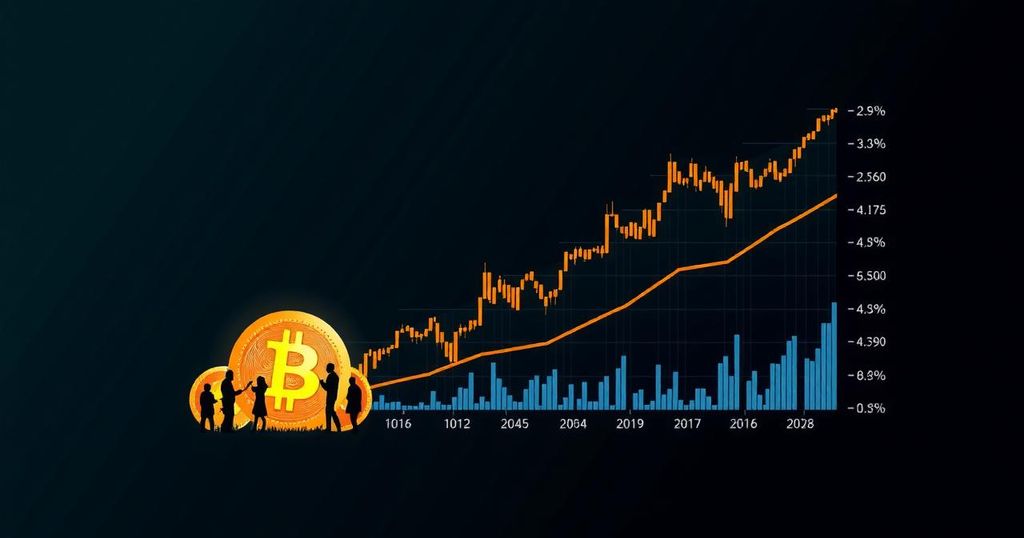Bitcoin Targets $65,000 Amid Optimism from Rate Cuts and Institutional Investing
Summary
Bitcoin has surpassed $62,000, rising 2.4% after the Federal Reserve’s dovish interest rate cut of 50 basis points. Institutional trading behaviors show less aggressive shorting, and Louisiana has introduced cryptocurrency as an acceptable payment, potentially increasing adoption. Nonetheless, concerns remain about inflation and economic stability, evidenced by economist Peter Schiff’s warnings. With technical indicators suggesting bullish momentum, Bitcoin may aim for a target near $65,379, although caution remains necessary.
As Bitcoin continues to exhibit signs of recovery, it has recently surpassed the $62,000 mark, following a 2.4% increase attributed to the U.S. Federal Reserve’s decision to implement a dovish 50 basis points interest rate cut. Insights from on-chain metrics provided by Ki Young Ju, founder of CryptoQuant, reinforce a bullish sentiment around Bitcoin, suggesting a shift in institutional trading strategies. Significantly, Bitcoin’s rise coincided with a historic economic context. The aggressive interest rate cuts from the Federal Reserve since the onset of the COVID-19 pandemic have correlated with a substantial rally in Bitcoin prices, which soared from approximately $5,000 to nearly $60,000. Conversely, the rate hikes instigated between March and December 2022 propelled Bitcoin’s value downward, culminating in a descent to around $16,000. The recent reduction in rates to a range of 4.75%-5.00% may rekindle optimism in a manner reminiscent of previous financial crises, albeit potentially less pronounced. In response to the Federal Reserve’s action, economist Peter Schiff criticized the rate cut, asserting, “As expected, the Fed caved to the markets and cut interest rates by 50 basis points. Not only will this round of rate cuts not stop a cooling economy from entering a recession, but it will also turn up the heat on inflation, making the recession that much worse.” Schiff’s observations underscore a cautious perspective regarding potential inflationary pressures, which may drive investors towards traditional safe-haven assets like gold rather than Bitcoin. Moreover, positive developments have emerged from the governmental landscape, as Louisiana State Treasurer, Dr. John Fleming, has announced that the state will now accept cryptocurrencies, including Bitcoin, as valid forms of payment. Dr. Fleming remarked, “In today’s digital age, government systems must evolve and embrace new technologies. By introducing cryptocurrency as a payment option, we’re not just innovating; we’re providing our citizens with flexibility and freedom in interacting with state services.” From a technical analysis standpoint, Bitcoin’s price has broken above relevant trendlines, and the Moving Average Convergence Divergence (MACD) indicator suggests bullish momentum. Should Bitcoin close above the 61.8% Fibonacci retracement level, it logically paves the way for further gains, potentially targeting the next resistance at approximately $65,379. However, should the price decline below $56,022, caution is advised, as this may forecast further bearish trends.
The article examines the recent resurgence of Bitcoin’s price following a reduction in U.S. interest rates, highlighting the historical impact of Federal Reserve monetary policy on cryptocurrency markets. It outlines the correlation between economic conditions and Bitcoin valuations, contextualizing current movements within overarching financial patterns. The significance of institutional trading behavior shifts and state acceptance of cryptocurrency as legal tender further informs the optimistic outlook for Bitcoin and similar assets. Ultimately, it presents a mixture of factual analysis and speculative observations surrounding Bitcoin’s price trajectory, influenced by global economic events.
Overall, Bitcoin’s upward movement after the Federal Reserve’s interest rate cut signals renewed optimism in cryptocurrency markets. Indicators suggest potential for continued growth; however, caution remains prudent amidst ongoing concerns of economic instability. The acceptance of cryptocurrencies by state governments reflects a burgeoning awareness and flexibility towards digital assets, potentially bolstering their legitimacy and adoption in the financial ecosystem.
Original Source: www.fxstreet.com








Post Comment